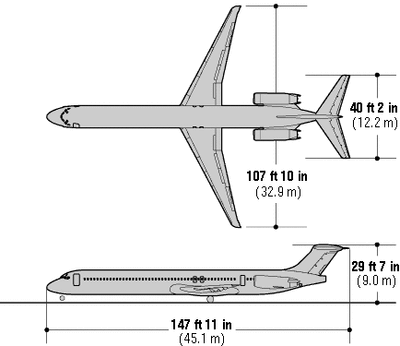Tue, Aug 18, 2009
Initial Findings From Spanish Investigators Indicate Need For
Safety Improvements
 Almost exactly a year ago, a Boeing
(formerly McDonnell Douglas) DC-9-82 (MD-82), operating as Spanair
flight JK5022, crashed after takeoff from runway 36L at Madrid
Barajas International Airport, Madrid, Spain. Of the 172 people
onboard, 154 died, including the 6 crewmembers; 18 passengers were
seriously injured. The flight was destined for Las Palmas de Gran
Canaria Airport in the Canary Islands. The airplane impacted a
field between the departure ends of runways 36L and 36R and was
destroyed by impact forces and postcrash fire. The investigation is
ongoing, but initial findings have identified the need for safety
improvements.
Almost exactly a year ago, a Boeing
(formerly McDonnell Douglas) DC-9-82 (MD-82), operating as Spanair
flight JK5022, crashed after takeoff from runway 36L at Madrid
Barajas International Airport, Madrid, Spain. Of the 172 people
onboard, 154 died, including the 6 crewmembers; 18 passengers were
seriously injured. The flight was destined for Las Palmas de Gran
Canaria Airport in the Canary Islands. The airplane impacted a
field between the departure ends of runways 36L and 36R and was
destroyed by impact forces and postcrash fire. The investigation is
ongoing, but initial findings have identified the need for safety
improvements.
An interim accident report by the Comisión de
Investigación de Accidentes e Incidentes de Aviación
Civil (CIAIAC) of Spain indicates that the leading edge slats and
trailing edge flaps were not extended during takeoff. This reduced
the airplane’s ability to achieve adequate aerodynamic lift.
The report also indicates that no takeoff warning system (TOWS)
annunciations were recorded by the cockpit voice recorder (CVR)
during the takeoff roll. According to the airplane manufacturer,
the TOWS should have annunciated a clear and audible aural warning
when the throttles were advanced to takeoff power while the
trailing edge flaps were not extended in a takeoff position. The
TOWS apparently had been disabled due to another problem with the
aircraft.
The NTSB determined that the probable cause of the accident was
the flight crew’s failure to use the taxi checklist to ensure
that the flaps and slats were extended for takeoff. Contributing to
the accident was the absence of electrical power to the
airplane’s TOWS, which, thus, did not warn the flight crew
that the airplane was not configured properly for takeoff. The
reason for the absence of electrical power could not be determined.
The NTSB now recommends that the FAA require that operators of
Boeing DC-9 series, MD-80 series, MD-90 series, and B-717 airplanes
include items in their preflight checklists to verify that a check
of the takeoff warning system is accomplished before every
flight.

Other recommendations from NTSB concerning this incident
include:
- Modifying 14 Code of Federal Regulations Part 25 to include a
certification standard that will ensure either that 1) the takeoff
warning system (TOWS) cannot be disabled by a single failure or 2)
if the system fails or has power removed while the airplane is
operating on the ground, a discrete and clear annunciation of the
loss of TOWS protection is provided to flight crews.
- Assessing the history of pilot errors related to takeoff
configuration and identify needed mitigating design elements;
require inclusion of such design elements when determining current
and future aircraft certifications.
- Convening a meeting of industry, research, and government
authorities, including international representatives, to develop
guidance on industry best practices in operational areas (including
checklist design, training, and procedures) that relate to flight
crews properly configuring airplanes for takeoff and landing.
- Requiring operators to modify their takeoff and landing
checklists to reflect the best practices identified as a result of
the meeting recommended in Safety Recommendation A-09-70.
More News
Light Gun A handheld directional light signaling device which emits a brilliant narrow beam of white, green, or red light as selected by the tower controller. The color and type of>[...]
"The journey to this achievement started nearly a decade ago when a freshly commissioned Gentry, driven by a fascination with new technologies and a desire to contribute significan>[...]
Aero Linx: JAARS, Inc. For decades now, we’ve landed planes on narrow rivers and towering mountains. We’ve outfitted boats and vehicles to reach villages that rarely se>[...]
"Our driven and innovative team of military and civilian Airmen delivers combat power daily, ensuring our nation is ready today and tomorrow." Source: General Duke Richardson, AFMC>[...]
Aircraft Conflict Predicted conflict, within EDST of two aircraft, or between aircraft and airspace. A Red alert is used for conflicts when the predicted minimum separation is 5 na>[...]
 ANN's Daily Aero-Term (04.20.24): Light Gun
ANN's Daily Aero-Term (04.20.24): Light Gun Aero-News: Quote of the Day (04.20.24)
Aero-News: Quote of the Day (04.20.24) ANN's Daily Aero-Linx (04.21.24)
ANN's Daily Aero-Linx (04.21.24) Aero-News: Quote of the Day (04.21.24)
Aero-News: Quote of the Day (04.21.24) ANN's Daily Aero-Term (04.21.24): Aircraft Conflict
ANN's Daily Aero-Term (04.21.24): Aircraft Conflict




